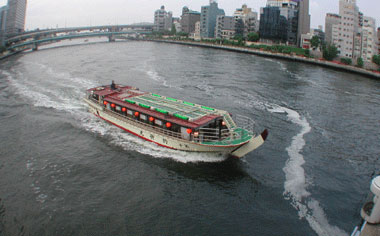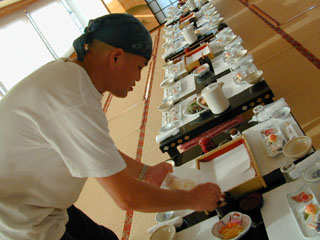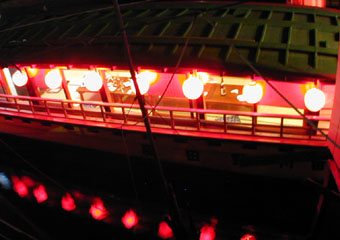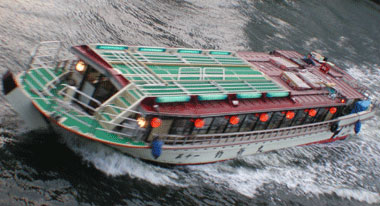Yakatabune Tradition: From Samurai to Salaryman
The Captain has been told dozens of times that he should occasionally cut back on that breakneck pace of his and, well, take it easy. They'll often say: loosen the tie every once in a while so a few of the hacks at the New York Times can take a reasonable run at the Pulitzer.
 This week he's doing just that. Join the Captain for a ride on a Tokyo pleasure ship. He promises beer on ice and three hundred and sixty-degree views.
This week he's doing just that. Join the Captain for a ride on a Tokyo pleasure ship. He promises beer on ice and three hundred and sixty-degree views.
The rules are simple: Don't attempt to recreate the "flying" scene from Titanic; don't jump in the water; and know where the life vests are stored.
"Each time before we depart I have to tell them," explains Kaoruko Mano, an eight-year veteran guide and server on a yakatabune (roofed-boat) with the Harumiya fleet of Tokyo's Koto Ward, of the precautions she must give to her passengers.
But many times they simply don't listen. The combination of a hot summer night, free-flowing alcohol, and the revelry between a few dozen colleagues or friends on a slow-moving boat cruising Tokyo Bay amid the city's reflected glow can captivate even the most timid of souls.
Mano remembers one young passenger, a new-hire in his early twenties, who was being encouraged repeatedly by his boss to take the plunge as the boat circled in front of the man-made peninsula of Odaiba. "I warned him not to do it, but while I was back in the galley tending to the propane stove..." She pauses and shrugs. "We rescued him, but I was so mad. We have to keep watch all the time."
As it was in the days of the samurai, taking a cruise in a wood vessel beneath blooming fireworks or cherry blossoms is a means of true relaxation. The amenities and surroundings may have evolved over the years, but the charm of being entertained while floating on the gentle wakes has remained untouched.
 Serving tempura, pouring drinks, providing historical commentary, and fishing guests out of the drink are all part of the job description for Mano, who describes herself as "a hostess on the water."
Serving tempura, pouring drinks, providing historical commentary, and fishing guests out of the drink are all part of the job description for Mano, who describes herself as "a hostess on the water."
Harumiya's operation comprises 5 boats and roughly 50 employees. Seven licensed yakatabune drivers ferry between 20 and 60 customers beneath the historic bridges and along the riverbanks that make up Tokyo's bayfront for cruises during both lunch and dinner.
Customers are treated like kings. As they lounge on zabuton cushions within the cabin, tossing back beer or whiskey, course after course of sashimi or tempura arrive from a server dressed in traditional yukata. Then, after the shoji (paper blinds) are pulled aside, full views of the glittering Tokyo nightscape are revealed.
Such grandeur isn't cheap. The price begins at 10,500 yen for each cruise, which ranges in length from 1 1/2 to 5 hours.
It is during the longer trips where the guests tend to get a bit restless. Moving to the bow with a loved one to extend both arms outward into the oncoming bay breeze like Kate and Leonardo is a common want for intoxicated passengers. Mano, though, holds firm: "Sometimes they get loud or crazy, but we have rules."
Generally, it is a year-round operation. The cold nights of February are the only true down times. Peaks are reached during the hanami (cherry blossom viewing) parties in April and the fireworks shows that run throughout August. On the busiest days, Tokyo Bay can seemingly be a sea of fireflies with the rows of red chochin lanterns dangling below the edge of each flat-topped boat bobbing gently above the water's surface.
 But as with most industries in Japan that rely on corporate spending, the overall business has slowed during these tough economic times. Mano notes that this year's Sumida River fireworks show had much less boat traffic than the year before. Additionally, it is not uncommon to hear of operators who have seen their monthly revenue slashed in half from that of the bubble economy days just over 10 years ago.
But as with most industries in Japan that rely on corporate spending, the overall business has slowed during these tough economic times. Mano notes that this year's Sumida River fireworks show had much less boat traffic than the year before. Additionally, it is not uncommon to hear of operators who have seen their monthly revenue slashed in half from that of the bubble economy days just over 10 years ago.
"They won't change anything," Mano says of the average operator's business strategy these days. (In a sign of the times, quite a few boats can be seen permanently docked within the narrow canals that radiate off the bay's main center.)
But some boathouses are indeed taking action. East Heaven Japan Co. is offering two-hour cruises for 4,900 yen. To be able to offer such a low price, the menu is centered around cheese monja - a sort pancake prepared with a variety of fillings.
Harumiya, however, doesn't have to resort to such cut-throat tactics to lure customers; its business is increasing because it fills a niche - that of catering to foreigners. Tie-ups with such travel agents as JTB and Kinki Nippon Tourist, as well as Mano's ability to speak English, have made Harumiya the boathouse of choice for out-of-town tourists and local corporate customers entertaining foreign guests.
"Sometimes we have too many customers," laughs Mano. "We have to give them to other operators."
Harumiya even configures its newer boats especially for foreigners. Kachidoki is a top-of-the-line foreigner ferry. Commissioned last December, the craft is wider and longer than what is standard; sunken wells beneath each table ensure guests need not sit cross-legged; and its ceiling rises over 6 feet above the tatami flooring to allow for easy movement within the cabin. The traditional lanterns and wood top have been ditched in favor a sleek white hull and large windows, further enhancing the impression of a western luxury liner.
 Started by the grandfather of the current owner, Kenichi Yasuda, as a fishing boat operation, Harumiya first began toting customers around Tokyo Bay 15 years ago. At the time, he figured, there was more profit to be made on top of the sea's surface than beneath it.
Started by the grandfather of the current owner, Kenichi Yasuda, as a fishing boat operation, Harumiya first began toting customers around Tokyo Bay 15 years ago. At the time, he figured, there was more profit to be made on top of the sea's surface than beneath it.
The look of a standard yakatabune of today is similar to that of the original vessels from some 400 years ago. The biggest physical difference - aside from a karaoke system replacing the onboard singers and story tellers that entertained the aristocracy in the early days - is the gasoline engine used to propel the craft; in days past, a long pole moving along the bay's bottom was enough to direct and move the boat.
Even though Tokyo's landscape is constantly adding glistening skyscrapers and artificial islands, Mano insists that the true yakatabune feeling of the samurai-era is still being kept. In fact, she says, a number of older Japanese specifically request one of Harumiya's two older boats - low ceilings and all - for a chance to recapture the past.
"Some people just like the old style," she says.
Note: Harumiya may be reached at (03) 3664-1344 or info@harumiya.co.jp

